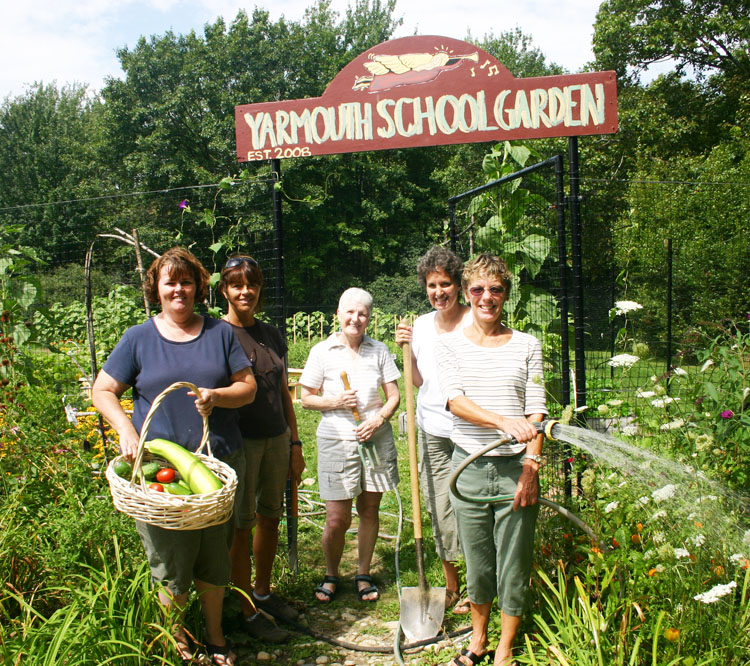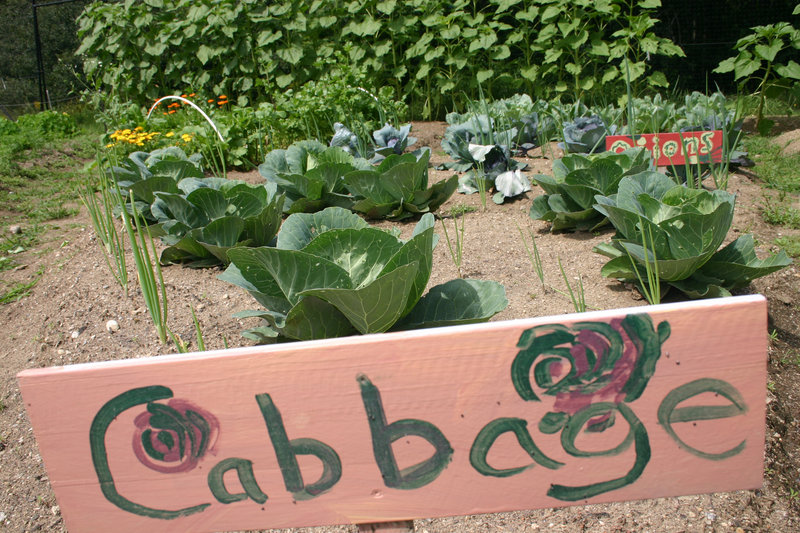Under the scorching August sun, Becki Schreiber sorts through a stack of drying garlic, wondering if she should braid it for storage. Nearby, Susan Stowell waters a raised bed bursting with corn stalks. At this time of year, these activities occur daily in gardens across Maine, making them unremarkable.
But when you consider that the garlic, corn, beans, peas and everything else growing in this 4-year-old, 6,000-square-foot garden behind Yarmouth Elementary School is destined for the district’s 800 daily meals, you catch a glimpse of the changing nature of school lunch.
“Our garden is a little different than other school gardens,” said Schreiber, director of Yarmouth’s school nutrition program. “Most began because a teacher wanted to incorporate it into the curriculum. Ours started because that’s what we wanted to feed our children.”
As public schools across Maine open for the fall term in coming weeks, students will see more fruits, vegetables and locally-sourced food, and a lot less processed food on their lunch trays. The trend to serve more healthy meals is driven by rising rates of obesity, an increased understanding of nutrition’s role in health, and a growing interest in supporting local agriculture.
“In Maine, we’ve woken up to the fact that some of our greatest economic resources are tied to our local food producers,” said Amanda Beal, who is wrapping up a research project commissioned by the nonprofit Cultivating Community. Her work examines what it takes to get more Maine food into local schools.
APPETITE FOR LOCAL LUNCH
Three years ago, Portland hired Ron Adams as its new food service director. Adams arrived in the state’s largest school district with a background in fine dining and a proven track record of enhancing the quality of school lunch during his tenure with the Gorham schools.
“A lot of what the school committee was interested in was how I was going to improve the food and bring in more local food,” Adams said.
One of the most visible changes in Portland this year is the addition of fruit and vegetable buffets at all nine elementary schools.
Less visible is the drive to make more dishes in-house and rely less on processed food.
“We’ve made pretty big strides in bringing scratch-made food back to Portland schools,” Adams said. “We still serve chicken nuggets once a month, but now we do breaded drumsticks made in-house and baked red potatoes instead of tater tots.”
Tater tots and french fries are also off the menu in Cape Elizabeth, where locally grown roasted root vegetables and sweet potato fries take their place and baked chicken breasts stand in for chicken nuggets.
Students in Cape Elizabeth no doubt will be happy to see the district’s popular Chef of the Month program continue. This year, chefs from restaurants that include Flatbread, Whole Foods and Sea Glass will come to the school once a month and prepare a meal for the students.
Peter Esposito, Cape Elizabeth’s nutrition director, credits the increased use of local foods, scratch-made meals and programs such as Chef of the Month with increasing the number of students who buy lunch.
“We have a lot more kids who eat (hot) lunch now,” he said.
Seventy percent of students purchased hot lunch last year, Esposito said, marking an increase of 10,000 meals over 2008.
“One thing I’ve never cared for is the hamburger you can get for free” from the U.S. Department of Agriculture, Schreiber said.
According to an investigative report published by the New York Times last winter, a portion of the USDA hamburger used by fast-food restaurants and the school lunch program has been treated with ammonia in an attempt to kill pathogens. However, repeated tests showed that the hamburger continued to be contaminated with E. coli and salmonella even after treatment. Reports such as these concern school food service directors.
A couple of years ago, Schreiber switched from the free USDA patties to Wolfe’s Neck Farm hamburger (now known as Pineland Farms Natural Meats). But when she learned the company’s livestock is sent to feedlots before slaughter, she sought out a new supplier.
For this year’s Maine Harvest Lunch – an annual local foods event at schools across Maine – Schreiber plans to debut hamburgers from Archer Angus Farm in Chesterville.
THE COST OF LOCAL
“Years ago, school lunch was, ‘Heat up the chicken patty,’ ” Schreiber said. “But before that, it was real food that was subsidized by the community. Now as there’s less junk being sold, school nutrition directors are hard-pressed for money. It’s more labor-intensive to go back to real food.”
With the help of grant funding, Portland schools investigated how much it costs the district to buy from local food producers. The results showed that for some items, such as the zucchini used to add fiber and reduce sodium in the school’s meat sauce, the cost is significantly less to buy local. For other items, such as fresh strawberries, the cost is higher.
“The strawberries were quite a bit more expensive, almost double the cost from California, but the quality was substantially better,” Adams said.
Because the berries were processed in the district’s central kitchen, the staff was able to preserve them with a quarter of the amount of sugar used in the cheaper commodity strawberries.
Averaged out over all the local products the district buys, it costs roughly a penny more per serving to incorporate Maine-grown and Maine-raised food, Adams said.
“If we buy it and process it ourselves, it’s cheaper than buying a processed chicken nugget,” Esposito said. “I’ve increased my labor costs, but my food costs have gone down.”
Staff Writer Avery Yale Kamila can be contacted at 791-6297 or at: akamila@pressherald.com
Send questions/comments to the editors.




